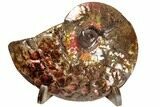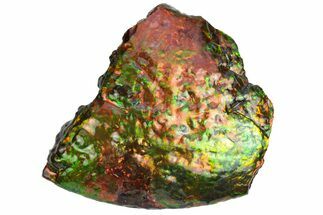This Specimen has been sold.
4.9" Brilliant, Iridescent, Ammonite (Ammolite) Fossil - Alberta
This is a stunning ammonite of the species Placenticeras costatum, collected from the Bearpaw Shale of Alberta, Canada (collected Summer 2021). It's entirely preserved in ammolite, a brilliantly colored, opal-like gemstone and features areas of well pronounced ribbing. The iridescent colors in this specimen are brilliant, and depending on which angle you view them from, you may see red, orange, green and/or small spots of blue-purple coloration. It comes with a display stand to assist with aesthetic display of this gorgeous ammonite specimen.
Colorful Canadian ammonites are cherished by collectors and are on display at most of the prominent museums in the world.
These ammonites are rare. The Canadian government considers them part of the “National Treasures of Canada”. For this reason, all ammonites must be inspected and registered by the Alberta provincial government. Each ammonite then receives a number and is entered in the provincial database. A cultural property export permit is required for them to be exported from the province. All documentation will be provided with the specimen.
Colorful Canadian ammonites are cherished by collectors and are on display at most of the prominent museums in the world.
These ammonites are rare. The Canadian government considers them part of the “National Treasures of Canada”. For this reason, all ammonites must be inspected and registered by the Alberta provincial government. Each ammonite then receives a number and is entered in the provincial database. A cultural property export permit is required for them to be exported from the province. All documentation will be provided with the specimen.
About Ammolite
Ammolite is an opal-like gemstone found primarily in Alberta, Canada. It is a kind of fossilized shell from ammonites, which in turn are composed primarily of aragonite, the same mineral contained in nacre (mother-of-pearl). The shell's microstructures are often preserved. In 1981, ammolite was given official gemstone status by the World Jewellery Confederation (CIBJO).
An iridescent opal-like play of color is shown in fine specimens, mostly in shades of green and red; howver, all the spectral colors can be seen. This iridescence is due to the aragonite's microstructure: unlike most other gems, whose colors come from light absorption, the iridescence in ammolite comes from interference with the light that rebounds from stacked layers of thin platelets that make up the aragonite. The thicker the layers, the more reds and greens are produced; the thinner the layers, the more blues and violets predominate. Blues and especially purples are the rarest colors, owing to the greater fragility of the finer layers responsible for these colors.
Ammolite is an opal-like gemstone found primarily in Alberta, Canada. It is a kind of fossilized shell from ammonites, which in turn are composed primarily of aragonite, the same mineral contained in nacre (mother-of-pearl). The shell's microstructures are often preserved. In 1981, ammolite was given official gemstone status by the World Jewellery Confederation (CIBJO).
An iridescent opal-like play of color is shown in fine specimens, mostly in shades of green and red; howver, all the spectral colors can be seen. This iridescence is due to the aragonite's microstructure: unlike most other gems, whose colors come from light absorption, the iridescence in ammolite comes from interference with the light that rebounds from stacked layers of thin platelets that make up the aragonite. The thicker the layers, the more reds and greens are produced; the thinner the layers, the more blues and violets predominate. Blues and especially purples are the rarest colors, owing to the greater fragility of the finer layers responsible for these colors.
About Ammonites
Ammonites were ancient marine cephalopods, similar to today's squids and octopuses, but with a defining feature: their distinctive, tightly coiled spiral shells. These shells, resembling those of modern nautiluses, served as both a protective home and a buoyancy aid, allowing ammonites to navigate the prehistoric seas with ease. First emerging around 240 million years ago in the Triassic Period, ammonites thrived for over 175 million years, adapting through numerous forms and sizes. As predatory creatures, they likely fed on smaller marine organisms, using their tentacles to capture prey. However, their long reign came to an end 65 million years ago at the close of the Cretaceous, coinciding with the mass extinction event that also eliminated the dinosaurs.
Ammonites were ancient marine cephalopods, similar to today's squids and octopuses, but with a defining feature: their distinctive, tightly coiled spiral shells. These shells, resembling those of modern nautiluses, served as both a protective home and a buoyancy aid, allowing ammonites to navigate the prehistoric seas with ease. First emerging around 240 million years ago in the Triassic Period, ammonites thrived for over 175 million years, adapting through numerous forms and sizes. As predatory creatures, they likely fed on smaller marine organisms, using their tentacles to capture prey. However, their long reign came to an end 65 million years ago at the close of the Cretaceous, coinciding with the mass extinction event that also eliminated the dinosaurs.
SPECIES
Placenticeras costatum
LOCATION
Korite Ammolite Mine, SW Alberta, Canada
FORMATION
Bearpaw Formation
SIZE
4.9 x 3.6" wide
CATEGORY
ITEM
#191706
We guarantee the authenticity of all of our specimens.
 Reviews
Reviews














